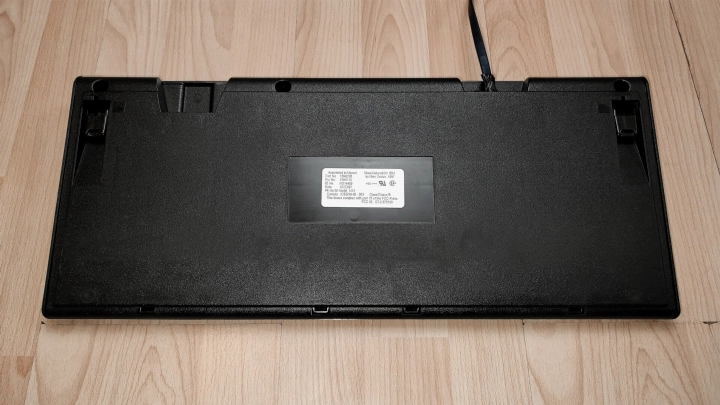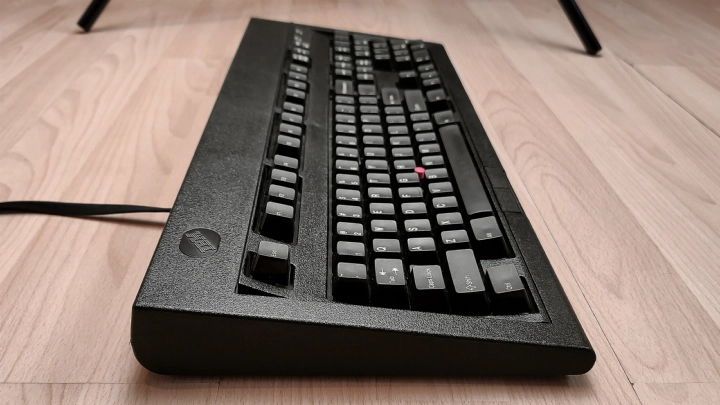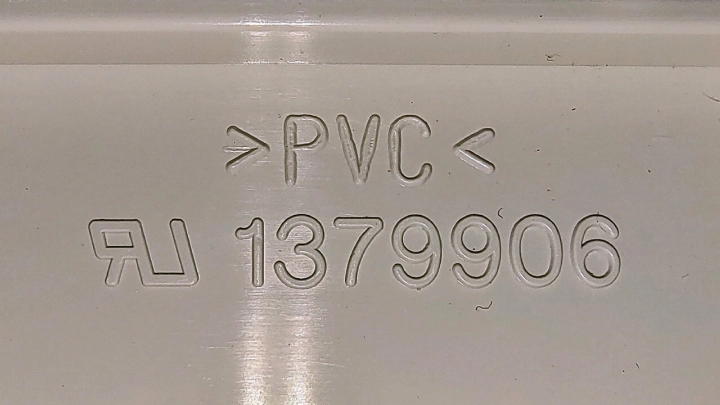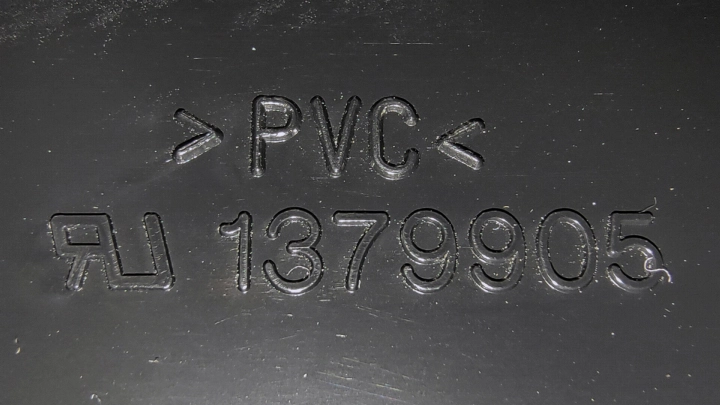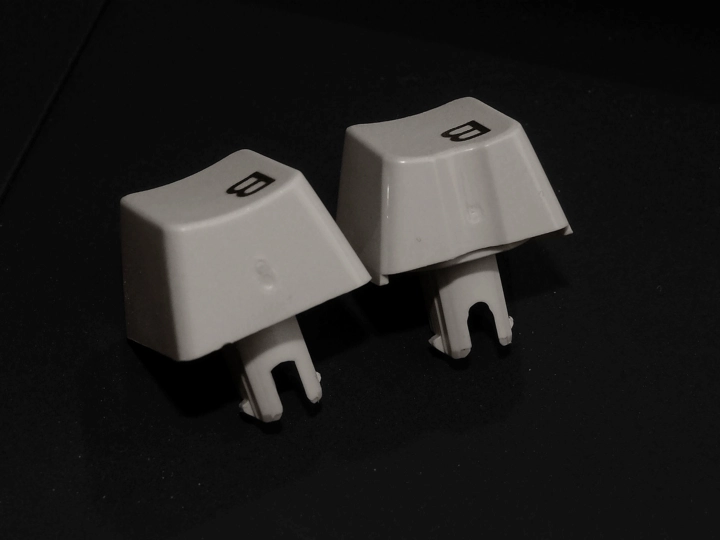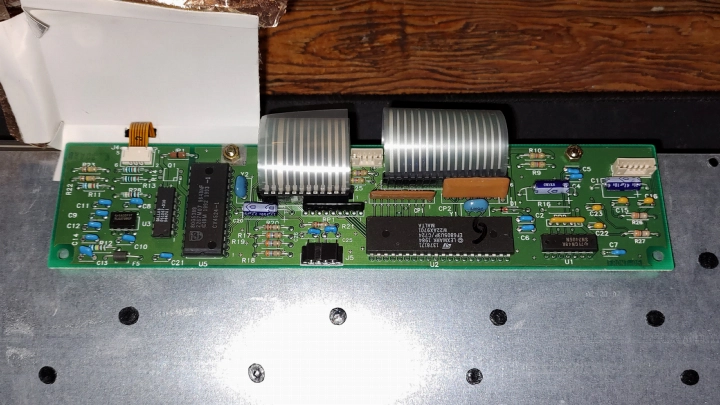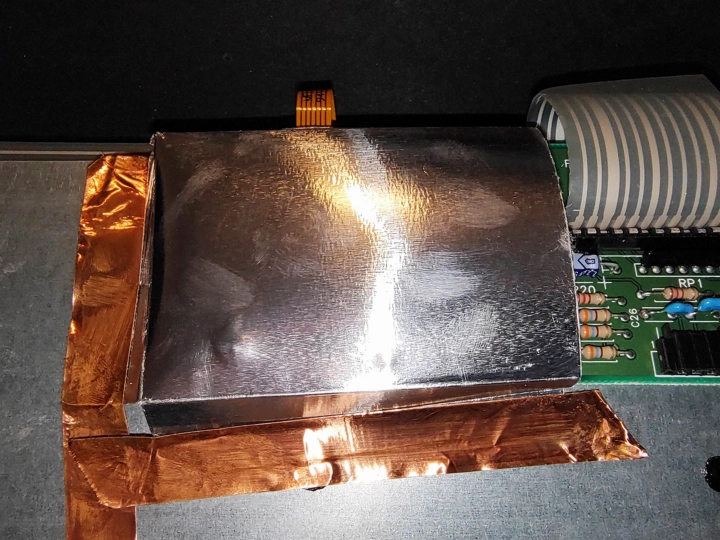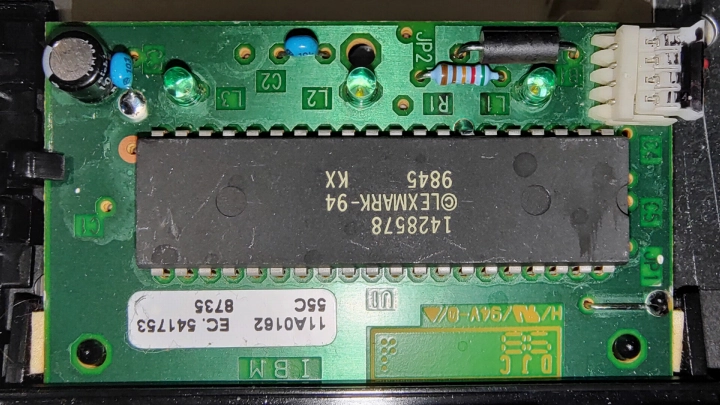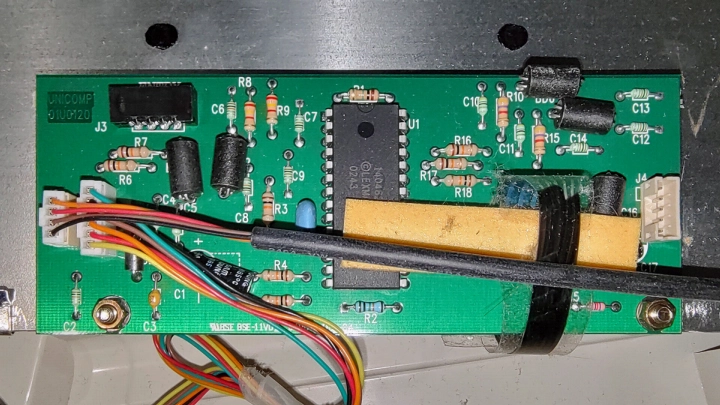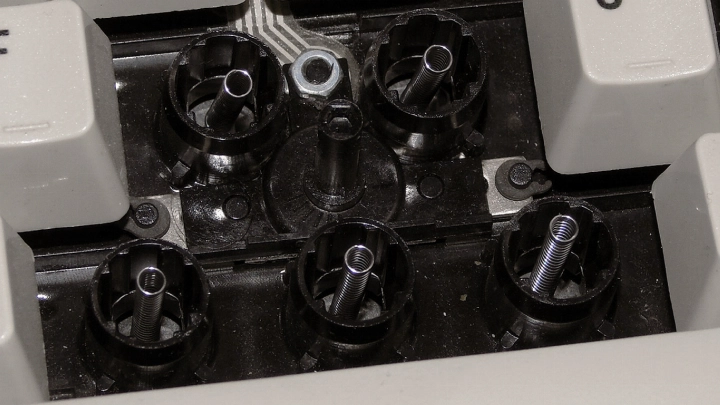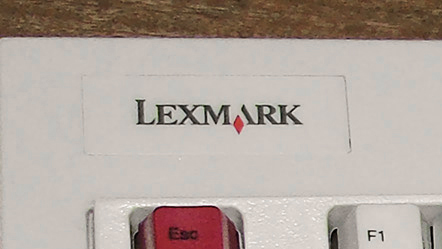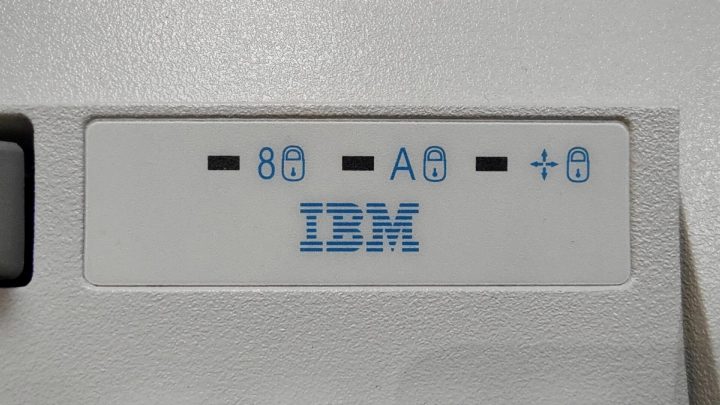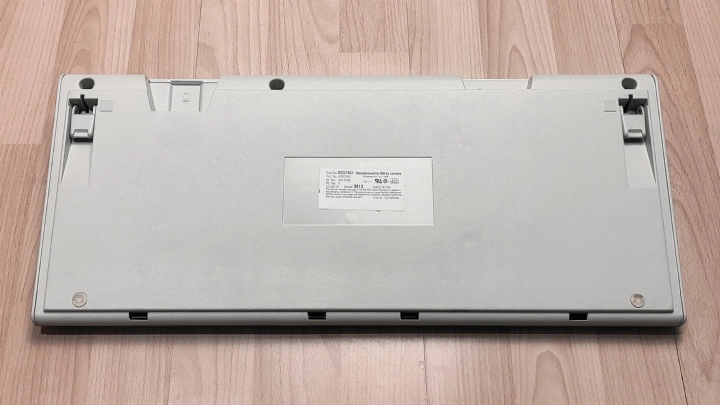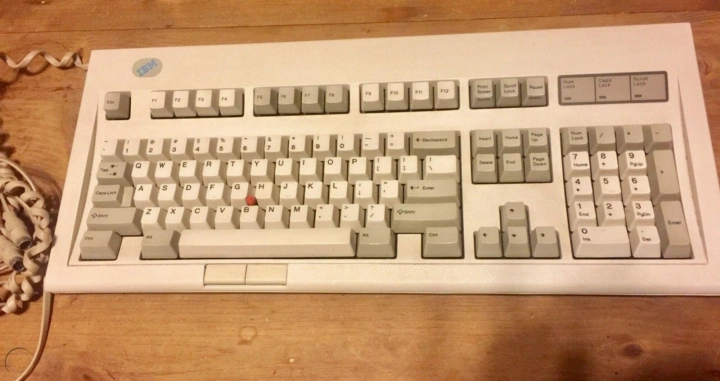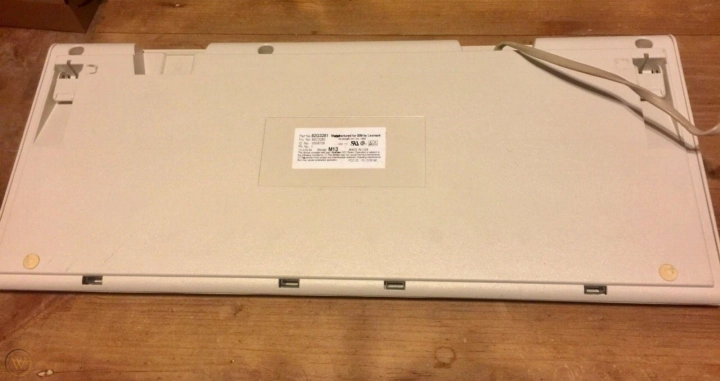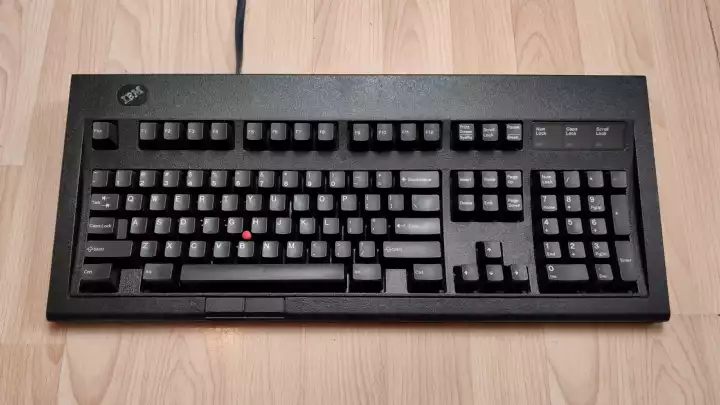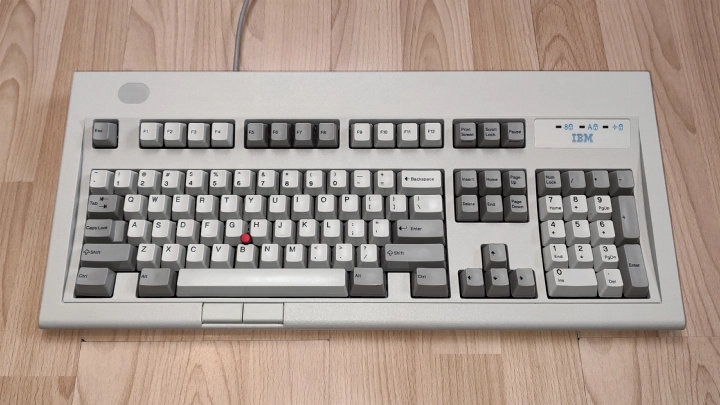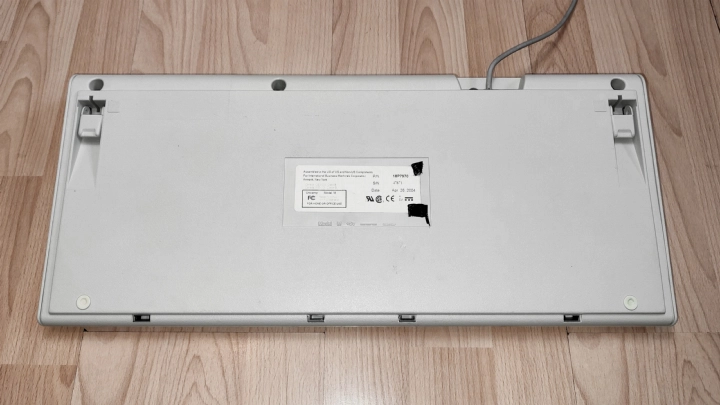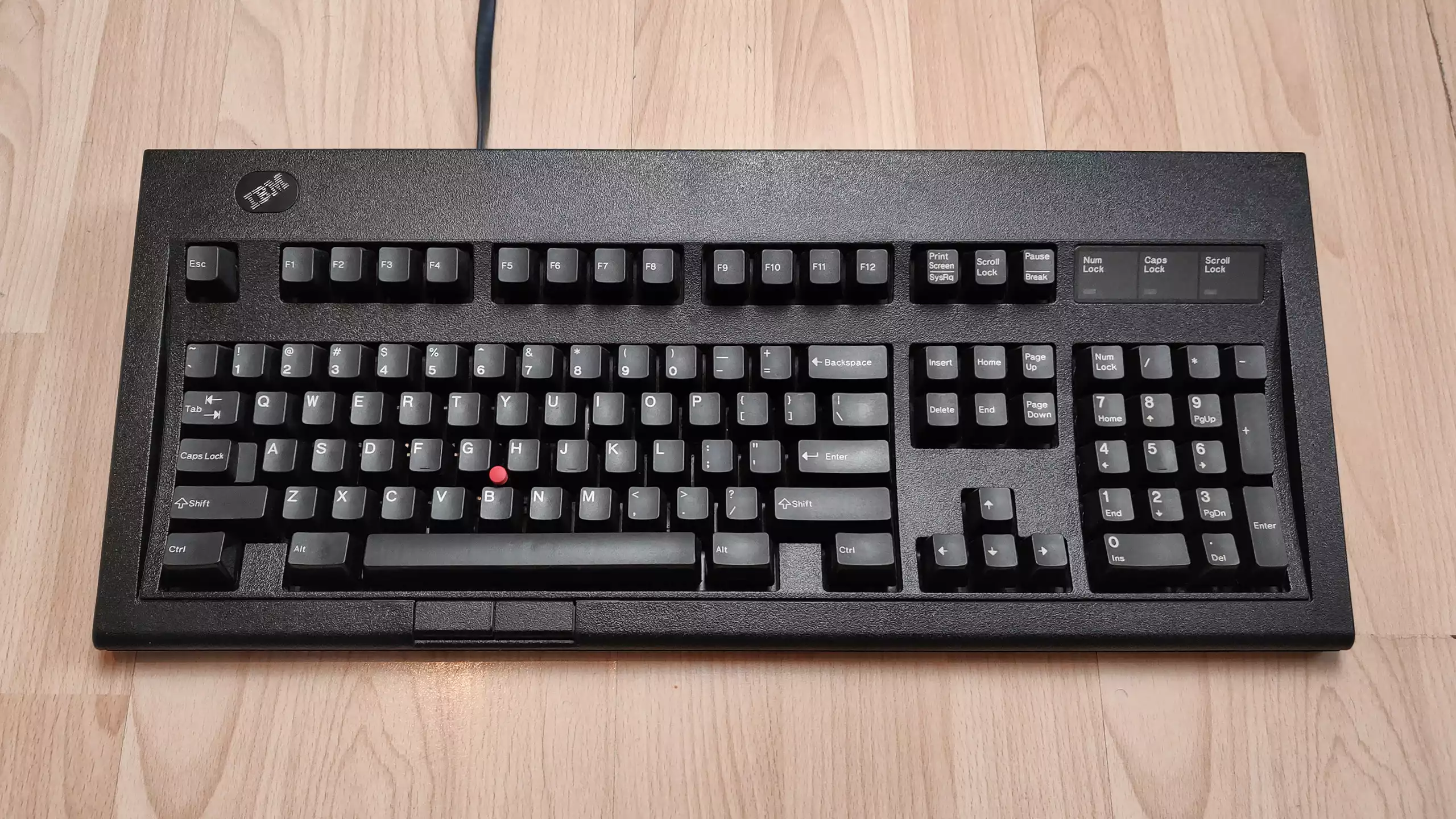Also applies to IBM Enhanced Keyboard with TrackPoint II, IBM Track Pointer Keyboard, Lexmark Classic with Integrated Pointing Stick, Unicomp On-The-Stick and Unicomp On-The-Ball Plus
- Updated
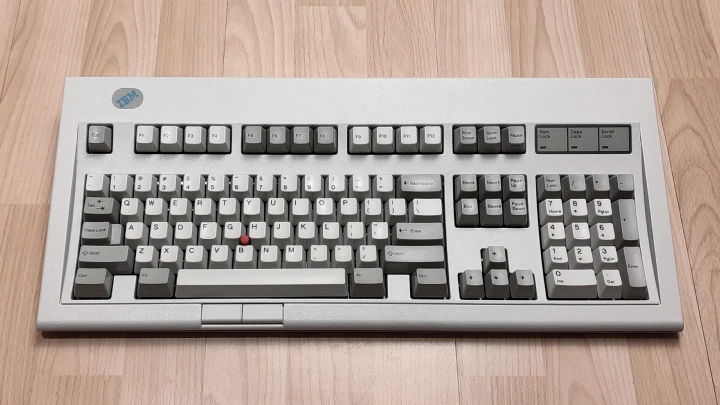
The IBM TrackPoint II Keyboard (designated Model M13) and its Lexmark and Unicomp siblings were variants of the standard IBM Enhanced Keyboard that adds a pointing stick in between the G, H and B keys much like their ThinkPad notebooks. A selling point from IBM was that it "eliminated the need for a mouse" by adding a device users may be familiar with from their laptops of the era. It was also touted as a way to increase productivity by keeping the users' hands on the keyboard at all times. Unlike the Model M4-1 Space Saver Keyboard with TrackPoint II released just before it and the many rubber dome and scissor-switch keyboards that came after it, the M13 retains their regarded clicky buckling spring key-switches, full-size Enhanced layout and in most cases high-quality dye-sublimated PBT keycaps.
M13s are a member of the large Model M family of keyboards introduced during Lexmark's tenure at the helm of the family that could be bought as an option for any PC or bundled with IBM systems through their Select-A-Keyboard scheme. Aforementioned Lexmark and Unicomp also put their names to the M13 with Lexmark in fact being the first to market an M13 in late 1993, a few months before IBM.
Contents
| Marketing names | IBM TrackPoint II Keyboard IBM Keyboard with TrackPoint II IBM Enhanced Keyboard with TrackPoint II IBM Enhanced Industrial Keyboard with TrackPoint II IBM Track Pointer Keyboard Lexmark Classic Touch Keyboard with Integrated Pointing Stick Unicomp On-The-Stick |
| OEM(s) | Lexmark, Maxi Switch, Unicomp |
| Designation | M13 |
| Family | Model M |
| FCC ID(s) | IYL1378190 IYL1404901 |
| Switches | IBM buckling spring (membrane variant) (most), IBM Quiet Touch rubber dome (factory option from Unicomp) |
| Keycaps | Dye-sublimated (pearl) or pad-printed (black) PBT |
| Case dimensions | 48.7cm x 20.7cm x 4.7cm (19.17" x 8.15" x 1.85") |
| Case material | PVC |
| Case colour(s) | Pearl white, raven black or industrial grey |
| Case screws | 7/32" (~5.5mm) hexagonal |
| Layout | 101 (ANSI) or 102 (ISO or split-spacebar ANSI) key full-size |
| Connectivity | PS/2 (most) or AT + DE-9 serial (some Lexmark-brand) |
| Notable features | TrackPoint II (IBM-brand Lexmark/Maxi Switch OEM), Lexmark-Unicomp FSR (Lexmark-brand/all Unicomp), PS/2 mouse passthrough (PS/2 only) |
| Successor | IBM TrackPoint IV Keyboard (for IBM), Unicomp EnduraPro (for Unicomp) |
Pricing
All inflation adjustments were made with US Inflation Calculator and any currency conversions were made with historical rates from OFX using the end of month rate.
| Date | Model | Original price | 2023 price (USD) |
|---|---|---|---|
| 1994-11-17 | OPTIONS by IBM raven black, P/N 13H6705 | $179 USD[1] | ~$368 |
| 1995-02-28 | OPTIONS by IBM pearl white, P/N 92G7461 | $250 CAD (~$179 USD)[2] | ~$358 |
| 1997-10-28 | IBM 7585/7587-1/7588, P/N 06H4173 | $389 USD[3] | ~$739 |
| 2000-04-07 | Unicomp On-The-Stick, P/N UNI0486 | $99 USD[4] | ~$175 |
Design
More information: Model M Enhanced Keyboard#Design
As the Model M13 directly derives from the standard IBM Enhanced Keyboard, many design details are applicable across both keyboards.
Key-switches
More information: IBM buckling spring#Membrane
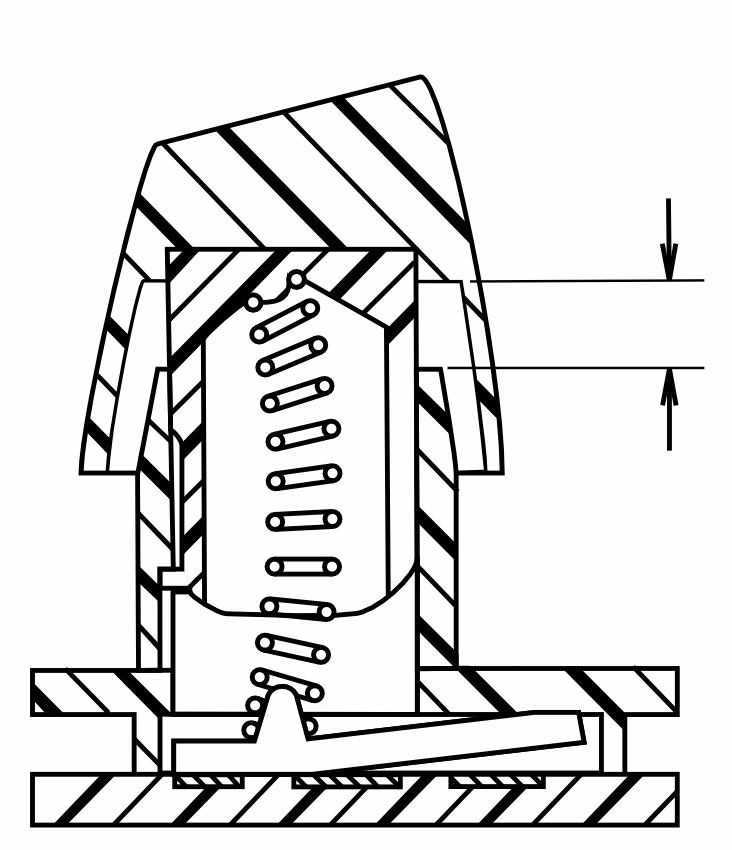
The most famous M13s use IBM's buckling spring over membrane clicky key-switch design. Such a switch is comprised of a coil spring, rocker (also known as a flipper or hammer) and the membrane circuitry underneath - pressing down on a buckling spring key causes the coil spring to compress and eventually buckle, which then rocks the flipper attached to the bottom of the spring thus actuating the membrane[6]. The mechanism rocks the membrane before its fully buckled (bottomed out), allowing for part-way actuation. Key-travel is 3.8mm.
When Unicomp took over production in the late '90s, they made their self-branded On-The-Stick keyboard available with Quiet Touch rubber domes as an option for those wanting the same keyboard layout, style and construction but quieter. However, key-travel is reduced to 3mm as a consequence[7].
Much like the Enhanced Keyboard, M13s can be easily identified by their unique wedge-shaped physical design that is seldom copied correctly by other manufacturers and they have a large space above the F-keys where the keyboard's branding typically resides. The keyboard's inner assembly is curved and partially swoops up above the F-keys and the case is designed to accommodate this, allowing for the space above it to hold items such as pens or pencils.
As seen from the embossed case stamps of both pearl white and raven black IBM-branded M13s from the mid-'90s, the case is usually made out of PVC just like the Enhanced Keyboard and it does not yellow with UV exposure. However, Lexmark and Unicomp self-branded M13s have been seen to yellow, implying a variance in the material they used. The mouse button pieces have also been seen to yellow.
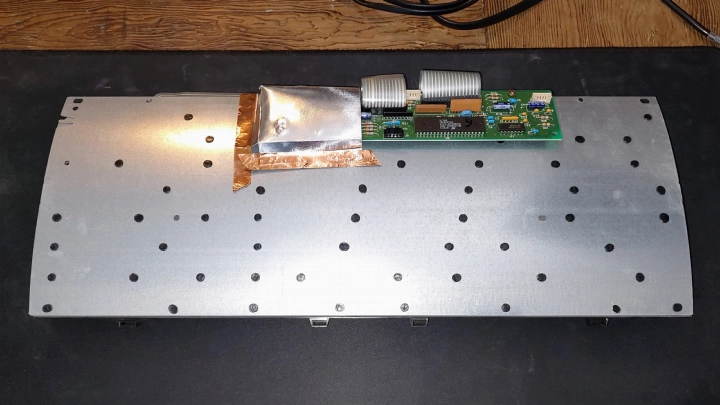
Just like the Enhanced Keyboard, the aforementioned curved assembly is comprised of four layers; the barrel plate and actuators, the membrane blanket, the membrane assembly, and the backplate.
- The barrel plate sits top facing and is used to guide the individual switch components (the buckling spring or Quiet Touch rubber dome actuators) to their correct position above the membrane assembly's contact points. The barrel plate design has a degree of redundancy in the number of barrels available, allowing for a 'one size fit all' design for ANSI and ISO layout keyboards. The pointing stick will also be mounted on top of the barrel plate. Like third-generation and newer Enhanced Keyboards, the barrel plate has channels to allow for fluid drainage.
- The membrane blanket (casually known as a "[rubber] mat") is a rubber or latex sheet used to dampen the stress the actuators exert on the membrane assembly. A Unicomp employee posting on /r/ModelM Discord has stated that a Model M without the blanket is unlikely to reach the rated 25 million key-presses lifetime[8].
- The membrane assembly is a part of the key-switch system used as the circuitry to be actuated and facilitates a 16x8 matrix.
- The backplate provides rigidity and the curvature for all the other layers to follow.
The assembly is held together by many plastic rivets designed to provide the tension needed for the buckling springs to operate properly. Unfortunately, these rivets are the single largest flaw in the Model M design as they can weaken and break with age. Such an issue can be permanently solved with a bolt or screw mod.
The keycaps are for the pearl white versions of the M13 IBM's famed PBT dye-sublimated variety. Versus the most common keycap material, ABS[9], PBT is more durable, does not degrade/yellow with age, UV or heat exposure, and will keep its texture for longer without shining[10]. Dye-sublimation is also a very durable text printing method that sinks dye material into the keycap's plastic itself, meaning there is nothing to quickly wear off as would be the case with pad-printing or silk screening. This means many vintage Model M keycaps will still be in good condition, requiring at most a good cleaning. M13 keycaps differ from the typical Enhanced Keyboard as they seem to always be single-piece instead of the famous two-piece variety that would normally allow a user to swap the keytop featuring the text legends instead of having to pull the entire keycap out of the barrel. It is likely forgone due to the fact a consistent key-stem could not be achieved for the G, H and later B keys that require a cut-out for the pointing stick. For the B-key specifically, a cut-out was not originally manufactured until Unicomp took over production (presumably to help give more clearance for their FSR stick).
The famous raven black M13 uses pad-printed legends instead due to the contrast limitation of standard dye-sublimation printing - the dye colour must be darker than the host plastic.
Controller
M13s have had two distinct types of controller cards much like the Enhanced Keyboard although the timeline of the transition from one to the other is slightly different. The first type was the more common Triomate-based flex cable connection controller card, which was then replaced by a pressure-based membrane connection controller card with an additional pointing stick controller card.
Triomate-based controller
The most familiar controller card is dubbed Triomate-based, named after the type of connector the membrane flex cables use - TE Connectivity's Triomate, pitched 2.54mm. M13s with this style of controller card also have lock-lights LEDs placed on a separate daughterboard. A typical M13 controller will accept three flex cables:
- 16-pin matrix connection
- 12-pin combined matrix and LED lock-lights connection
- 4-pin mouse buttons connection
Such controller cards may also have a piece of shielding covering the pointing stick electronics.
Pressure-based controller
In 1995, the introduction of the P/N 42H1292 Enhanced Keyboard and its EMEA/SA counterparts saw the move from Triomate-based controllers to a smaller, simpler card that is connected to the membranes' traces by pressure alone. This 25-pin pressure-based controller is sometimes referred to as the "overnumpad controller" due to the fact it's positioned just above the numeric keypad keys. Due to this, the LED lock-lights were placed on the controller itself, eliminating the need for an LED lock-light daughterboard. The LEDs are also placed different compared to the old daughterboard due to the position of the membrane connection pins and the large IC, which is what gives fourth-generation Enhanced Keyboards and similarly-equipped M13s their characteristic lights that are aligned in the middle of their external overlay instead of bottom left. The change in controller also reduced the part count and power consumption significantly, with Unicomp Customizers circa 2001 drawing at most ~30 milliamps with LED lock-lights turned on compared to 90 to 130 milliamps for older IBM and Lexmark era Enhanced Keyboards[11].
Lexmark and Maxi Switch didn't implement this change on M13s by themselves, instead, Unicomp did so sometime between 1998 and 2003. However, instead of designing a completely new controller card, they reused the Enhanced Keyboard overnumpad controller card as is and instead routed its PS/2 output through a second controller card positioned behind the keyboard assembly used for handling the pointing stick. The pointing stick controller still retains a 4-pin Triomate socket for the mouse buttons.
Integrated pointing stick
More information: IBM/Lenovo TrackPoint pointing stick and Lexmark-Unicomp FSR pointing stick
IBM-branded M13s made by Lexmark and Maxi Switch have been observed to always sport TrackPoint II pointing sticks as their marketing implies. TrackPoint II features strain gauges and is the same stick found on the Model M4-1 Space Saver Keyboards and Models M6 and early M6-1 based IBM ThinkPad keyboard assemblies albeit with extra height. TrackPoint II lacks the negative inertia transfer function feature of the later TrackPoint III and IV revisions (the latter of which is still used by Lenovo today), meaning its performance can be less than ideal on modern high-resolution displays, but it's generally an accurate stick. It contrasts well against the alternative such as the Lexmark-Unicomp FSR pointing stick Lexmark's self-branded and all Unicomp M13s utilise. Whereas TrackPoint II is an isometric (stationary) stick, the FSR stick moves like a small joystick. Regardless of implementation though, the performance of the sticks can be boosted on modern systems via software solutions such as interception drivers.
Flip-out feet
More information: Model M Enhanced Keyboard#Feet
M13s utilise the same flip-out feet as the IBM Enhanced Keyboards they derived from.
Branding
'90s M13s follow similar branding styles to Enhanced Keyboards of the era, which for IBM-branded keyboards results in IBM blue-on-grey ovals being used for pearl white (IBM's term for off-white) keyboards and silver-on-black logos for raven black keyboards. Industrial M13s used the latter when they were produced by Lexmark or Maxi Switch then the former when they were produced by Unicomp. The host colour of the keyboard is also reflected on the colour scheme of the lock-light overlay, with raven black M13s receiving a likewise raven black overlay and pearl white or industrial M13s receiving a pebble (IBM's term for dark grey) overlay.
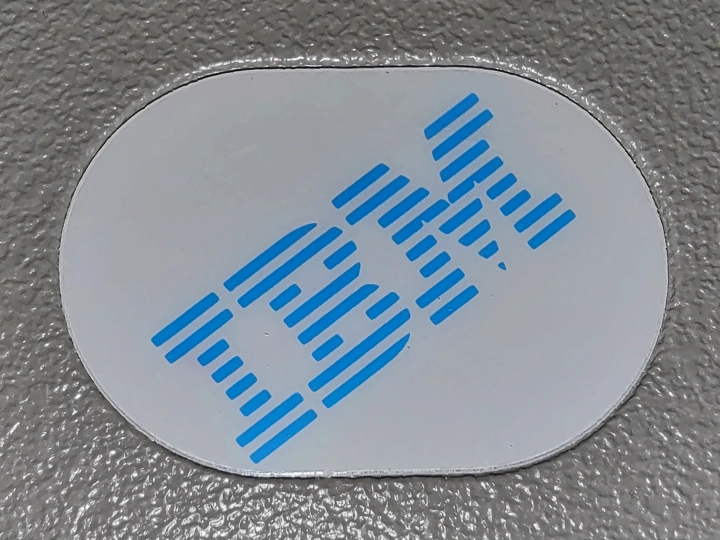
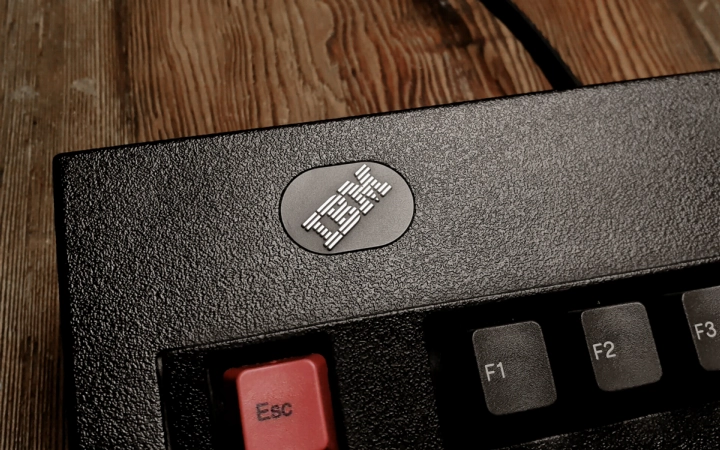
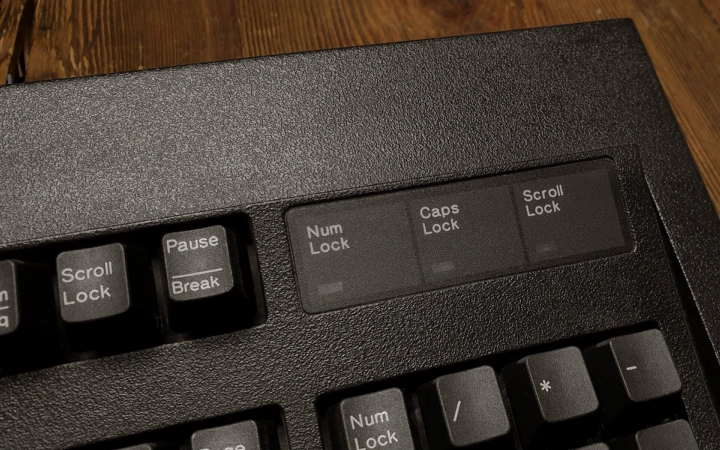

Lexmark-branded M13s also use the same rectangular logo as their non-stick Lexmark Classic counterparts. Unicomp used its signature logo printed on the lock-light overlay. 2000s IBM-branded M13s produced by Unicomp had the IBM logo printed on the lock-light overlay.
Layout
More information: Model M Enhanced Keyboard#Layout
All Model M13s use the same ANSI and ISO style layouts as the IBM Enhanced Keyboards they derived from.
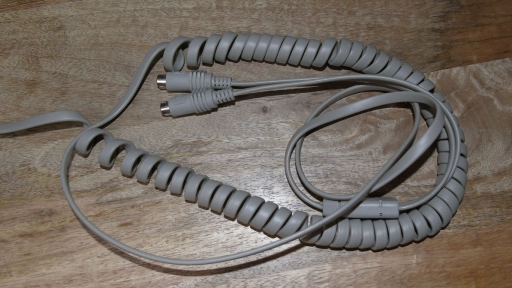
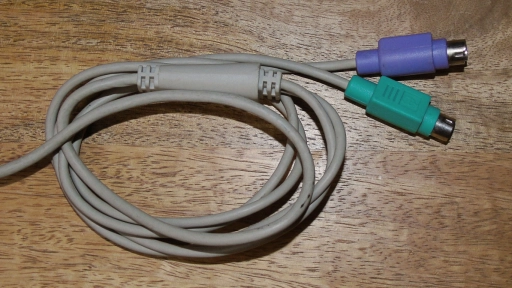
All known M13s have attached cables that can be coiled (Lexmark, Maxi Switch and early Unicomp OEM) or straightened (late Unicomp OEM). Typically, the cable is a Y-split PS/2 cable although Lexmark self-brand M13s were known to often come with an AT (5-pin DIN in 180-degree pin arrangement) plug for the keyboard and a DE-9 RS232 serial connector for the mouse.
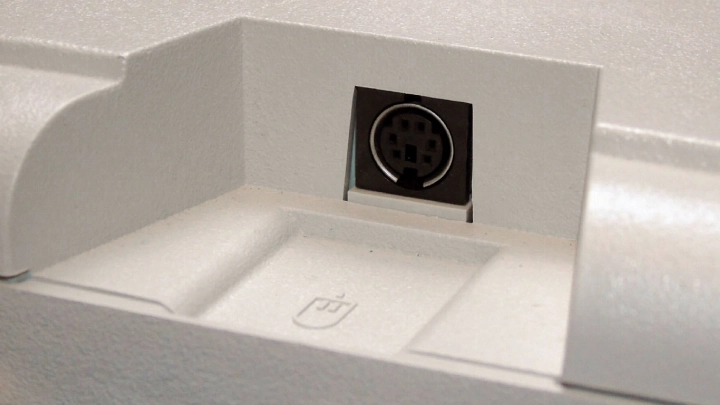
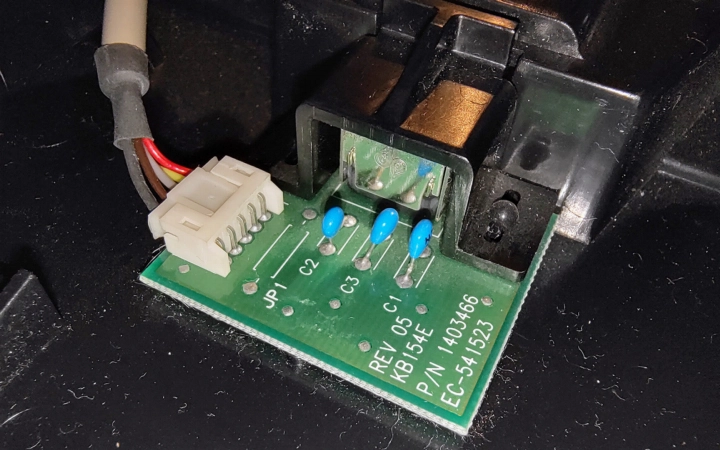
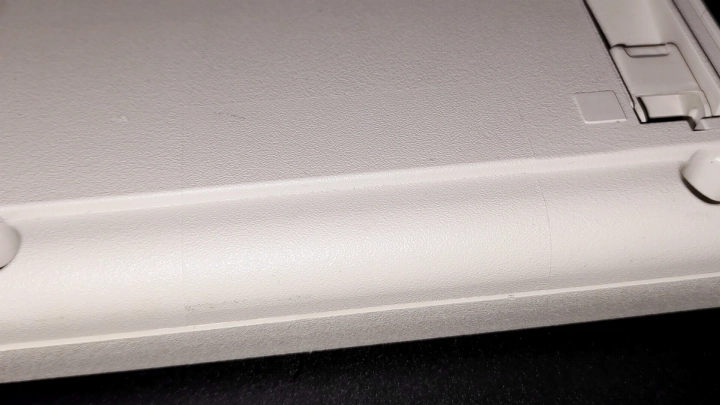
PS/2 M13s are known for their PS/2 mouse pass-through port, facilitated inside via a daughterboard that simply passes the signal to the controller card for relaying to the host system. The daughterboard also has 3 capacitors that are believed to serve as decoupling capacitors, presumably for protecting the controller and cleaning signals. M13s that use a serial connection for the mouse will have this port fitted with a blanking plate from the inside. Unicomp-made IBM-branded M13s for the IBM 3494 has the entire area filled in via the mould.
eg, P/N 1403380
The first Model M13s observed are the Lexmark-branded Classic Touch Keyboard with Integrated Pointing Stick, which first appeared in advertising sometime between May and November 1993[12][13] in the form of the Erase-Eaze Option seen below. Whilst the basic form of the keyboard is the same as the later, more famous IBM-branded M13s, Lexmark-branded M13s such as P/N 1403380 differ with their rectangular-shaped branding, use of FSR pointing stick technology, and are typically found with an AT DIN connector for keyboard comms and DE-9 RS232 serial connector for mouse comms instead of PS/2. As such, the PS/2 mouse pass-through port found on most IBM-branded M13s is blanked out for such Lexmark-branded M13s.

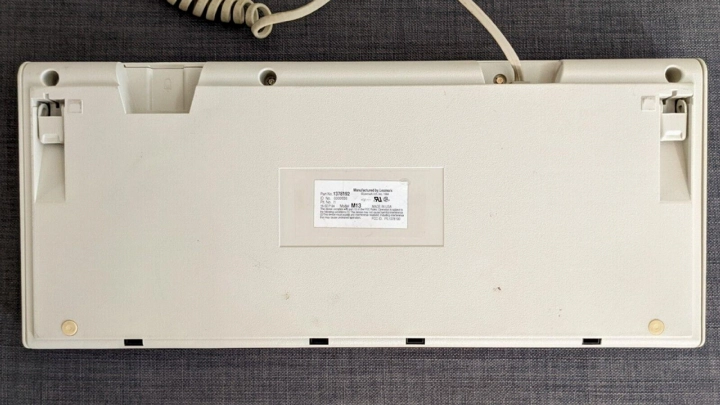
eg, P/N 1378192
As the name implies, the Lexmark-branded M13 with Erase-Eaze option is a version of the above Lexmark Classic Touch Keyboard with Integrated Pointing Stick with the trademarked ERASE-EAZE feature where the spacebar is split into two keys with one functioning as a backspace key. ERASE-EAZE is a trademark of Keyboard Advancements, Inc. filed in March 1993[15] and in Lexmark's case the smaller left key is used as a backspace. The keyboard is also PS/2 compatible with an attached Y-split cable like IBM-branded M13s but still retains Lexmark's FSR pointing stick instead of TrackPoint II. Like the base keyboard, it appeared in Lexmark's marketing sometime between May and November 1993.
On 28th February 1994, IBM introduced the OPTIONS by IBM scheme that included the first IBM-branded Model M13 keyboard - the IBM Enhanced Keyboard with TrackPoint II - as part of its initial line-up[16]. As the name applies, these M13s are simply the IBM Enhanced Keyboard with a TrackPoint II pointing stick and two complimentary mouse buttons fitted and a large cut-out on the back made for a PS/2 mouse pass-through port. P/N 92G7461 (with US ANSI layout) seems to be the sole part number. OPTIONS for IBM was a catalogue for IBM products and accessories to be sold standalone for IBM and non-IBM systems.
eg, P/N 82G3281
The only M13 known to be bundled with non-industrial IBM PCs was the IBM Keyboard with TrackPoint II which was a part of IBM's Select-A-Keyboard scheme, which allowed customers of IBM systems of the period to choose from a variety of keyboards for their system at the time of purchase for no additional charge. P/N 82G3281 is the main Select-A-Keyboard M13 part number that appeared as early as June 1994[18] and was eventually joined by P/Ns 82G3283 (Latin American Spanish) and 82G3285 (French Canadian)[19]. Production started in advance and examples from as early as February 1994 can be found[20]. Compared to the other M13 releases, Select-A-Keyboard M13s were the most significant way to obtain an ISO layout M13 with TrackPoint II instead of an FSR pointing stick via the latter two part numbers. All Select-A-Keyboard M13s had pearl white cases and were identical to the OPTIONS by IBM counterpart shown above.
The raven black version of the OPTIONS by IBM M13 - the IBM TrackPoint II Keyboard (Black), alternatively designated KB 705 - is simply the black follow-up to P/N 92G7461 that was made available 30th November 1994[1]. It is considered to be the most iconic M13. Whilst the keyboard's assembly, electronics, pointing stick and how it was sold were unchanged, P/N 13H6705 (the sole part number known) uses pad-printed keycaps due to the contrast limitations with dye-sublimated keycaps (the host plastic needs to be lighter than the ink being sublimated). This means the keycap legends can wear with use, scrapes or even light chemical attack. They also use a raised silver on black style IBM oval badge similar to IBM's industrial keyboards.
The IBM Enhanced Industrial Keyboard with TrackPoint II is an industrial grey version of the Model M13 intended for the IBM 7585 (all models), 7587 Model 1, and 7588 (all models) Industrial Computers under feature code 6045[3]. As with IBM Enhanced Keyboards and Space Saving Keyboards before them, this industrial version featured a characteristic slightly olive-tinted grey cover set that was believed to have been designed to hide the dirt and damage expected to be inflicted upon the device within an industrial environment. Otherwise, the keyboard was mechanically the same as its non-industrial counterparts.
The earliest example found was produced by Lexmark for IBM in late 1995, sporting a TrackPoint II pointing stick and an IBM black oval badge with raised silver text[21]. The following year, Maxi Switch produced versions are known and built to the same basic design. By at least 1998, Unicomp had taken over production, moving the design to a more standard IBM blue oval badge and now using their FSR-based pointing stick (despite the marketing name still saying "TrackPoint II"). Maxi Switch examples use FRU number 06H4842, whereas Lexmark and Unicomp examples use the same FRU number as the part number.

eg, P/N UNI0486
The Unicomp On-The-Stick was the continuation of consumer Model M13 production under Unicomp after Maxi Switch stopped producing the raven black IBM-branded M13 in 1998. The On-The-Stick was initially available with just Quiet Touch rubber dome key-switches when it first appeared on Unicomp's website in December 1998[23], with the buckling spring version finally appearing in March 2000[7]. At first, the On-The-Stick was a continuation of the Lexmark-branded M13s that used FSR pointing sticks already, but Unicomp eventually updated the design to include more clicky mouse buttons and a typical fourth-generation Model M pressure-fit controller card much like P/N 42H1292 era IBM Enhanced Keyboards. The On-The-Stick was "no longer available" as of 1st June 2007[24]

eg, P/N UNI0496
The Unicomp On-The-Ball Plus was perhaps the most unique M13-derived keyboard ever released. It sold only for only a relatively short time in the 2000s and is essentially a merger of the Model M5-2 (Unicomp On-The-Ball) and the above On-The-Stick. It first appeared on Unicomp's website in January 2000 and was marketed as being a keyboard that could be "convienent for all users"[25]. The trackball module was the same 25mm module used on Model M5-2s, however as expected, the pointing stick was Unicomp's signature FSR-based stick.
eg, P/N 18P7970
The IBM 3494 Track Pointer Keyboard that was available for the IBM TotalStorage 3494 Enterprise Automated Tape Library is the latest IBM-branded Model M13 known, introduced extremely late for an IBM Model M and is quite possibly the last IBM buckling spring keyboard released. It first appeared by October 2003 in the 16th edition IBM 3494 Parts Catalog referred to as both the "Track Pointer Keyboard" and erroneously "Keyboard, Track Ball"[26]. It replaced actual trackball keyboards (likely Model M5-2s) mentioned in previous editions of the same Parts Catalog, which is probably the source of the aforementioned typo. In terms of architecture, it's based on the Unicomp On-The-Stick and likewise uses an FSR pointing stick instead of TrackPoint, which may also explain why IBM distinctly called these "Track Pointer" keyboards instead of "TrackPoint". This keyboard also lacks a PS/2 mouse pass-through port that '90s Model M13s had.
Part number list
18 keyboard part numbers have been found in the ASK Keyboard Part Number Database. If you believe a relevant part number is missing, you can help improve this list by requesting a submission for it to be added.
- P/N 06H4173 (FRU 06H4842): IBM Enhanced Industrial Keyboard with TrackPoint II (6045)
- P/N 1378192: Lexmark Classic Touch Keyboard with Integrated Pointing Stick and Erase-Eaze Option
- P/N 13H6705: IBM TrackPoint II Keyboard (Black)
- P/N 1403380: Lexmark Classic Touch Keyboard with Integrated Pointing Stick
- P/N 1428405: Lexmark Classic Touch Keyboard with Integrated Pointing Stick
- P/N 18P7970: IBM 3494 Track Pointer Keyboard
- P/N 18P7971: IBM 3494 Track Pointer Keyboard
- P/N 18P7972: IBM 3494 Track Pointer Keyboard
- P/N 18P7973: IBM 3494 Track Pointer Keyboard
- P/N 18P7974: IBM 3494 Track Pointer Keyboard
- P/N 82G3281 (FRU 82G3282): IBM Keyboard with TrackPoint II (9081)
- P/N 82G3283 (FRU 82G3284): IBM Keyboard with TrackPoint II
- P/N 82G3285 (FRU 82G3286): IBM Keyboard with TrackPoint II
- P/N 92G7461: IBM Enhanced Keyboard with TrackPoint II
- P/N KB-102TPTB-UK: Unicomp On-The-Ball Plus
- P/N UNI0486: Unicomp On-The-Stick
- P/N UNI0496: Unicomp On-The-Ball Plus
- P/N UNI2496: Unicomp On-The-Ball Plus
Internal
- M13: Lexmark versus Unicomp article
- IBM - Options by IBM: TrackPoint II Keyboard (Raven Black) -- PS Style (13H6705) (#194-361) [accessed 2022-09-30].
- IBM - Price Reductions on Selected IBM Products (#A95-185) [accessed 2022-09-30].
- IBM - Price Changes: Selected Models and Features for Data Collection and Industrial Computer Products (#A97-1438) [accessed 2023-10-01].
- Unicomp - On-The-Stick [accessed 2022-10-03]. License/note: retrieved via Wayback Machine (2000-04-07 capture).
- Shaddim - File:Bucklingspring-animation-300ms.gif [accessed 2021-09-09]. License/note: CC-BY-2.0.
- IBM - Rocking switch actuator for a low force membrane contact switch [accessed 2021-06-17].
- Unicomp - On The Stick [accessed 2022-10-03]. License/note: retrieved via Wayback Machine (2000-03-04 capture).
- troyfletcher#5223 - Discord Message #252446027745853442 on IBM keyboards | /r/ModelM & F [accessed 2023-02-21].
- WASD Keyboards - Mechanical Keyboard Guide [accessed 2022-07-01].
- Switch And Click - ABS vs PBT Keycaps: What’s the Difference? [accessed 2021-09-09].
- Scott W. Vincent - Power Consumption of IBM Model M Keyboards [accessed 2025-04-02]. License/note: retrieved via Wayback Machine (2022-03-29 capture).
- PC Mag - 1993-05-25 [accessed 2022-05-29].
- PC Mag - 1993-11-23 [accessed 2022-05-29].
- ohaimark - eBay listing photos. License/note: used under fair dealing.
- Deskthority Wiki - Backspace key#Erase-Eaze [accessed 2022-10-04].
- IBM - Options by IBM: Overview (#194-052) [accessed 2022-01-23].
- WorthPoint - IBM Keyboard Model M 13 Part Number 82G3281 [accessed 2022-09-30]. License/note: saved from volatile eBay listing via WorthPoint & used under fair dealing.
- IBM - IBM PS/2 76 and 77 Family of Systems and Options (#194-206) [accessed 2022-08-17].
- IBM - PC Server 310 - FRU-P/N Cross Reference (EMEA) (#JBAR-3WDP8W) [accessed 2022-08-17].
- Phosphor Glow - 82G3281 – M13/Trackpoint II – February 17th, 1994 [accessed 2022-09-30].
- ASK Keyboard Photos Archive - P/N 06H4173 (1995, Lexmark) [accessed 2022-12-02]. License/note: photos by HellGalaxy#9688.
- Unicomp - PStkbig.jpg [accessed 2022-10-02]. License/note: retrieved via Wayback Machine (2007-02-09 capture) and used under fair dealing.
- Unicomp - Enhanced Quiet Touch with Pointing Stick [accessed 2022-10-03]. License/note: retrieved via Wayback Machine (1998-12-06 capture).
- Unicomp - On-The-Stick [accessed 2022-10-03]. License/note: retrieved via Wayback Machine (2007-06-01 capture).
- Unicomp - On The Ball Plus 101 [accessed 2022-09-30]. License/note: retrieved via Wayback Machine (2000-01-15 capture).
- IBM - IBM TotalStorage Enterprise Automated Tape Library 3494 Parts Catalog (#18P9782) [accessed 2022-08-17].
| Published | Comment |
|---|---|
| 4th April 2024 | Updated Enhanced Industrial Keyboard with TrackPoint II photos and info, added its price and FCC ID & updated the inflation adjusted prices from 2021 to 2023 |
| 5th February 2024 | Fixed broken keyboard rear label photos |
| 1st June 2023 | Remove duplicate "OPTIONS by IBM (raven black), TrackPoint II Keyboard (Black) (1994)" link |
| 1st June 2023 | Add various new 1403380 photos & 1403380's FCC ID in "Summary" |
| 19th April 2023 | Add part number list section |
